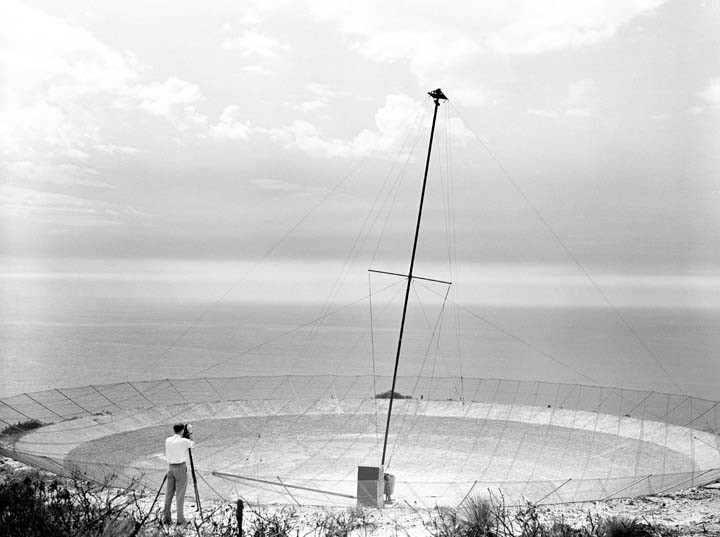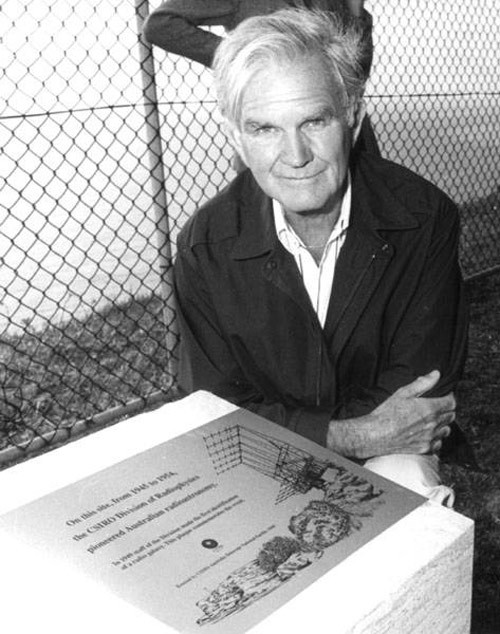The pioneering radio astronomer in Australia died at age 92
One of Australia's pioneering radio astronomers, Owen Bruce Slee, recently died at the age of 92 in his homeland.
Owen Bruce Slee joins a group of astronomers with the opposite view of British astronomer Sir Fred Hoyle. He was honored by the International Astronomical Society by an asteroid named after him, the asteroid 9391 Slee.
In the 1950s, while working with Bernard Mills' research team, Mr. Slee and his colleagues Alec Little and Kevin Sheridan made an observation and since then there has been conflict with British astronomer Hoyle. , when his team's expansionary model replaced the cosmic model with Hoyle's steady state.

One of Australia's first radio telescopes, glass built by Bruce Slee and Gordon Stanley.(Photo: ANTF).
Slee was trained since World War II, when he was a pilot working in radio and radar. This work made him more interested in radio astronomy . When he was a sergeant working at a radar station near Darwin, he observed the Sun's corona over a radio frequency at 200 MHz.
Mr. Slee is not the only person making war discoveries. Because he had no chance to learn and exchange with other discoverers, his discoveries were still a mystery.
When Dr. Joe Pawsey made his entry to Slee's radio astronomical group into the Commonwealth Scientific and Industrial Research Organization (CSIRO) in 1946, he moved to Sydney with his family and worked Technical assistant for radio astronomy and physics.

Portrait of Owen Bruce Slee.(Photo: ANTF).
When Slee and Gordon Stanley and John Bolton worked at CSIRO, they discovered James Star in the UK .
Working at Antenn Yagi on the Sydney coast of Dover Heights, the three together demonstrate the signals coming from the constellation Cygnus by various sources: the Crab Nebula, two colliding galaxies, and two galaxies. separate.
Slee is also involved in an observation project in China with a 500-meter diameter Apeture Spherical telescope. 22m holes between the glass plates and connect them together with metal lines to make the whole mirror glass monolithic.
With the beachside antenna, all three scientists worked together to find every corner of the central part of the Milky Way. When funded, the team built a modern eye for a curious telescope.
Telescope Mills Cross was named after chief engineer Bernard Mills of the group, categorized more than 2000 radio signals, and accidentally pulled the group into controversy with one of the astronomical monuments, Mr. Fred Hoyle from Dai study Cambridge.

Telescope This Mills Cross has helped make a university's hypothesis a reality.(Photo: ANTF Historic Photograph Archive).
From Hoyle's point of view, Mills Cross's calculations were probably wrong. Hoyle worried about the results of Mills' classification list because it countered the previous British survey that the universe was a silent model.
Mills Cross's results show that signals are derived from a large and distant object in the expanding universe. At this time, Australian scientists were caught in the middle of the dilemma, because their results made Cambridge's results false.
Slee astronomer participates in many important jobs at major scientific agencies in Australia: Parkes Radio Telescope, Culgoora Telescope Chain and Australia Telescope Chain.
The Australian National Telescope, which commented on him: "Over 70 years in the profession, he has made important contributions to expanding knowledge from the solar system (solar ion, solar sun flower). , interplanetary environment, understanding Jupiter and comets) to galaxies (pulsars, different active stars, gas dust nebulae, intergalactic environments), or even quasar bodies and galaxy clusters ".
- 60 whales die from stranding in Australia
- Australia would like to install a radio telescope SKA
- Discover radio history and radio technology
- Signal detection of 5 billion years old, preceding the solar system
- Who invented radio?
- The great female scientist who confirmed the existence of dark matter has died
- Telescope Australia detects more mysterious radio signals
- Australia, South Africa build super telescopes
- Radio waves work to lower blood pressure
- For the second time, science has found a source of mysterious radio waves
- Norway became the first country to
- Yahoo wants to regain the pioneering position?
 The most famous scientific failures in history
The most famous scientific failures in history Mysterious genius mechanic and the machine froze time
Mysterious genius mechanic and the machine froze time The son carries the 'bad gene' of genius Albert Einstein
The son carries the 'bad gene' of genius Albert Einstein Isaac Newton
Isaac Newton